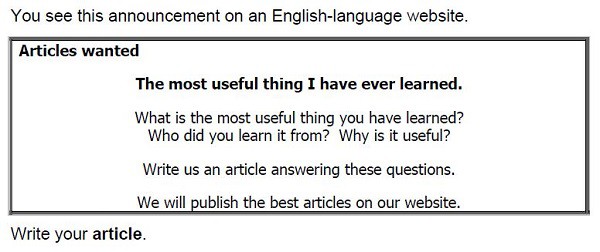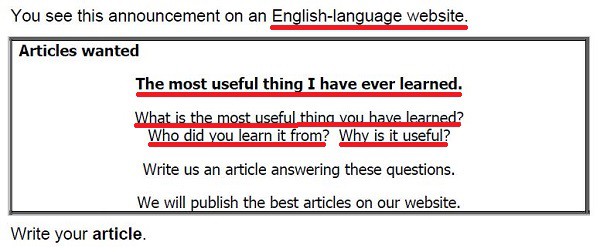How To Find Out When An Article Was Published Online
Summary
- Mandatory task: no
- Word count: 140-190
- Main characteristics: interesting, engaging, personal opinion / comment
- Register: semi-informal to informal
- Structure: Title/introduction, 2-3 topic paragraphs, closing paragraph / conclusion
- Language: adjectives/adverbs, colloquial expressions, phrasal verbs, idioms, linking words, interesting grammar
- Example:
The most useful thing I've ever learned
Have you ever learned something that completely changed your life? I can remember exactly how it was for me when I got interested in learning English and who helped me become the person I am today.
I had always been in love with English music and I put in some work by myself, but only when I ended up in the English class of Mr. Weiss I got completely hooked. His amazing style of teaching struck a chord and my skills skyrocketed in no time.
Feeling confident, I took the leap and moved to beautiful Australia where I was able to travel and even call it home for over seven years. And you know what?! I became an English teacher and now help people who are just like I used to be with the same passion as Mr. Weiss.
I really think that I wouldn't be teaching English had it not been for Mr. Weiss and his inspirational lessons. So, looking back, I hope my experience inspires others to find ways to help the people around them as well.
Introduction
An article is usually written for an English-language magazine or newsletter, and the reader is assumed to have similar interests to the writer. The main purpose is to interest and engage the reader, so there should be some opinion or comment.
from: Cambridge English First Handbook for Teachers
Articles are part of the second section of the FCE writing exam. This means, that, actually, you can decide if you want to choose this type of text or, instead, pick one of the other ones available in this part (a review, report, letter/email or, if you take FCE for Schools, a story).
Articles are interesting and engaging
You might think that I'm joking because how could writing an article be interesting and engaging? The thing is that I'm not talking about you as the writer, but about the reader. Articles are less formal than, for example, an essay or a letter of application so they are usually more interesting and engaging to read.
However, keeping this in mind, writing an article can also become more fun. If you keep thinking about what would be interesting for the reader, it is easier and more engaging for you too.
So, in this article we are going to look at similarities which we can find in almost every FCE article writing task, such as structure, requirements, useful language and other things to pay attention to. This way, I hope you will feel more confident and knowledgeable.
What a typical article task looks like
Even though there are many different topics to write articles about and they might change a lot from exam to exam, there are certain similarities that I don't want you to miss and with a little practice you will be able to find these characteristics really fast in every single task.

When you see a task like this (and please remember this for the future) you have to check two things:
- What do you have to include in your article?
- Who is going to read it?
Below you can see that I have underlined the key pieces of information for you and don't forget to do the same with every writing task you see.

OK, let's start with what we have to include. In the box I underlined three questions we have to answer:
- What is the most useful thing you have learned?
- Who did you learn it from?
- Why is it useful?
There are three topic points to write about and you will see that there are always three things that you have to include in your articles. If you can't find three topic points, then look again because they must be there.
The second question I asked above was about who is going to read your article. In this case we are going to write for an English-language website, which means that normal people like you and me are the target readers.
In the FCE writing exam you always have to consider the reader of your texts as you have to adjust the register (formal, neutral, informal language) in your writing. With different levels of formality come different things you should or shouldn't write, but in articles we normally expect the readers to be people like us so we can write in a more informal style.
Informal English means that you should use contractions like 'I'm' or 'don't', colloquial words and expressions, for example, 'awesome' or 'tons of'. Also, try to add some phrasal verbs because they are definitely a feature of informal language as well and last but not least, involve the reader personally by addressing them directly and even ask a question or two.
Again, always look out for three topic points to include in your article and be prepared to use informal language. If you cover all of this, you are already on a very good way to pass. However, there are still a few more things to consider.
How to organise your article
OK, we went through the first step analysing the task. Now we need to think about how we can organise the article so it is logical and with all the different parts included and well connected.
This step might be a little bit different from task to task, but, generally speaking, you can follow this process every time and you should be alright.

Can you remember the three things we have to include in our article? Yes, you can? You are a very good student 🙂 . We have to talk about what the most useful thing you've ever learned is (1), who you learned it from (2) and why it is useful (3).
It probably makes sense to give each of these points a paragraph in our article so we already have three sections. To me it seems as if we could use the first topic point in our introduction, which means that we don't need a separate one, but it is always nice to have a short closing paragraph (similar to a conclusion in an essay). Adding that and a title, we end up with four paragraphs and our article would look like this:
- Title & Introduction / Topic point 1 (What is the thing you learned?)
- Topic point 2 (Who did you learn it from?)
- Topic point 3 (Why is it useful?)
- Closing paragraph / conclusion
Of course, there is always the option of separating the intro and the first topic point or combining two topic points in one paragraph and again, this depends on each task, but, in general, this is what every article looks like in the FCE exam.
Always make a plan
I can't say it often enough, but, unfortunately, this is something that drives me crazy and a lot of students simply forget to do.
Always plan your articles before you start writing. It takes just a few minutes to create a list of paragraphs like the one above with a couple of words to remind you of what you want to write added to each heading.
There is nothing worse than writing for 25 minutes and then realising that you have to change something or move around different parts. Don't make the same mistake and write a plan.
The different parts of an article
In this part of my post we are going to look at the different sections of an article in the FCE exam using our task from above so I can give you example paragraphs which include everything you should put in there as well if you want to become the boss of article writing.

Introduction
In your introduction you always want to get the reader interested in your article. Your goal is to make the reader want to continue. As always, there are a couple of things for you to remember when you start writing:
- Give your article a title.
- Start with a personalised question.
- Include the topic and give your opinion or comment on it.
An example could look like this:
The most useful thing I've ever learned
Have you ever learned something that completely changed your life? I can remember exactly how it was for me when I got interested in learning English and who helped me become the person I am today.
There you have it. My article has a title, which doesn't have to be super creative, the intro includes a question as well as the topic and my comment ("…helped me become the person I am today.") and I've already answered the first topic question in the task (What is the thing you learned?).
I also kept some information to myself (Who did I learn from? Why is it useful?) so the reader wants to continue. Try to keep them guessing as this can be very engaging.
Topic points
Once we have our introduction ready and our readers can't wait to find out more, we need to think about how we can present the rest of the information.
In our plan we decided to break the topic points up into two paragraphs, but we also have to focus on the other requirements of an FCE article:
- Stick to the topic and don't write about unrelated things.
- Support your answers with some examples and/or reasons.
- Use neutral to informal language (check the section 'What a typical article task looks like' above to find out what that means).
- Use other language to make your article sound more interesting (adjectives/adverbs, idioms, phrasal verbs, linking words, play with some grammar).
And with all of this in mind, I wrote these two paragraphs:
I had always been in love with English music and I put in some work by myself, but only when I ended up in the English class of Mr. Weiss I got completely hooked. His amazing style of teaching struck a chord and my skills skyrocketed in no time.
Feeling confident, I took the leap and moved to beautiful Australia where I was able to travel and even call it home for over seven years. And you know what?! I became an English teacher and now help people who are just like I used to be with the same passion as Mr. Weiss.
As you can see, I broke everything up in two paragraphs and only wrote about the questions supporting my answers. On top of that, I included a lot of useful informal language (highlighted).
Closing paragraph / Conclusion
Last but not least, we want to round off our article with a good closing paragraph. In the conclusion we want to achieve a few different things:
- Summarise what you wrote in your article.
- Comment on the topic or give your opinion one last time.
- End your article in an interesting way.
The last paragraph shouldn't be too hard to write if you've done a good job with your introduction and topic paragraphs. Because we have done exactly that further above in this post the conclusion becomes something like this:
I really think that I wouldn't be teaching English had it not been for Mr. Weiss and his inspirational lessons. So, looking back, I hope my experience inspires others to find ways to help the people around them as well.
I put everything together nice and short. I summarise the points I made in the introduction and the topic paragraphs, gave my opinion ("I really think…") and also addressed the reader directly again to end my article in an interesting way.
How your article is marked
Marking FCE writing tasks is like a science and for a lot of students it feels as if there is this big mystery and nobody really knows how it works. Actually, there are very clear rules that the examiners have to follow and the criteria are publicly available.
While it is possible to find all the information on your own I thought it would be a good idea to put everything together in an article for you. Check out how your writing tasks are marked by clicking here.
Practice makes perfect
With all this detailed information it is now time for you to get active. Look for different example tasks online and follow my step-by-step process to improve and become an expert when it comes to writing FCE articles. All you need is experience until you can find the different characteristics discussed here so you can write your texts almost on autopilot.
Please let me know if you like my post and if there are other things I can include or improve. Until then, happy practice.
Lots of love,
Teacher Phill 🙂
How To Find Out When An Article Was Published Online
Source: https://teacherphill.com/fce-how-to-write-an-article/
Posted by: bairdanowbod.blogspot.com

0 Response to "How To Find Out When An Article Was Published Online"
Post a Comment